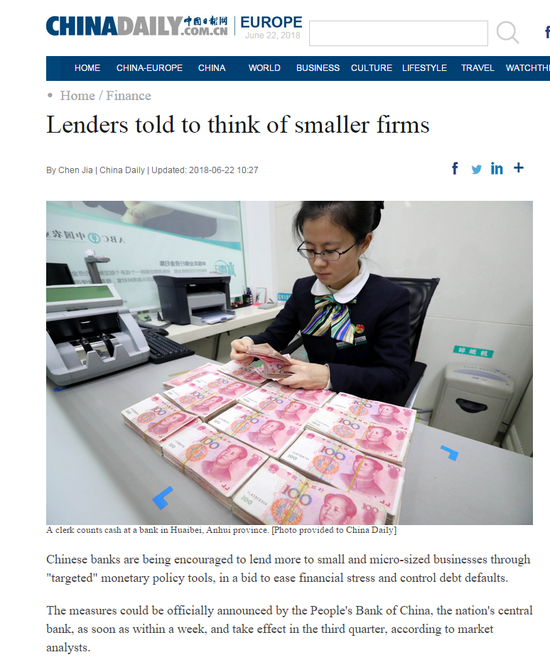 原文截图
原文截图中国日报援引分析人士称,“定向降准”等货币政策措施最快一周内由央行正式宣布,并在第三季度生效。在周三的国务院会议上,李克强总理明确要求,当天研究部署的小微企业融资政策要尽快出台,并由相关部门机构在年底汇报结果。
以下为原文:
Lenders told to think of smaller firms
By Chen Jia | China Daily
Chinese banks are being encouraged to lend more to small and micro-sized businesses through “targeted” monetary policy tools, in a bid to ease financial stress and control debt defaults.
The measures could be officially announced by the People‘s Bank of China, the nation’s central bank, as soon as within a week, and take effect in the third quarter, according to market analysts.
The tools include another cut to the reserve requirement ratio (RRR), the cash amount that financial institutions are required to hold. But the lower ratio is only for lenders providing loans to small and micro-sized businesses, according to a statement issued following a meeting of the State Council on Wednesday.
“Targeted easing”, rather than altering the “prudent and neutral” tone of monetary policy, is necessary to prevent risks given the rising downside pressures on economic growth, said Li Qilin, a senior researcher of Lianxun Securities.
“It is also to offset the negative shocks that private and smaller firms suffer”, said Li. “But a broader monetary easing may not appear in the short term.”
Nomura Chief China Economist Lu Ting predicted that this reduction could vary from 50 to 150 basis points for different types of financial institutions, just like the measure announced in last September when the central bank estimated that 450 billion yuan ($69.28 billion) of liquidity could be injected into the banking system.
After the upcoming cut, the RRR for Chinese financial institutions is likely to be 15-16 percent, still a relatively high level among emerging economies.
China‘s central bank made its first targeted cut to the ratio - a creative monetary policy tool - in April 2014, allowing county-level rural commercial and cooperative banks to lend more money by cutting their RRR by 50-200 basis points.
The latest targeted reduction of the ratio took place on Jan 18, a cut of 50 basis points for financial institutions if they issued new loans exceeding 1.5 percent of their total lending in 2017 to small and micro-sized enterprises, agriculture-related sectors, impoverished groups and students. An additional reduction of 100 basis points could be made for lenders if this proportion was larger than 10 percent.
Financial tightening or deleveraging since 2017 has resulted in financial stress in the corporate sector, especially for private and small-sized companies. The closure of shadow banking operations, increased default cases in the bond market and stock market fluctuations led borrowers back to traditional bank loans.
However, financial institutions‘ risk appetite has also changed as they prefer more safe and short-term lending under tight regulation. State-owned companies, usually with an implicit guarantee by local governments, are their priorities to issue loans to rather than private and small companies, said experts.
A recent central bank survey indicated that in the second quarter, smaller firms had higher financing demands than larger ones, as credit growth slowed amid regulatory tightening, although the credit-to-GDP growth gap has narrowed.
责任编辑:李彦丽
热门推荐
收起
24小时滚动播报最新的财经资讯和视频,更多粉丝福利扫描二维码关注(sinafinance)








